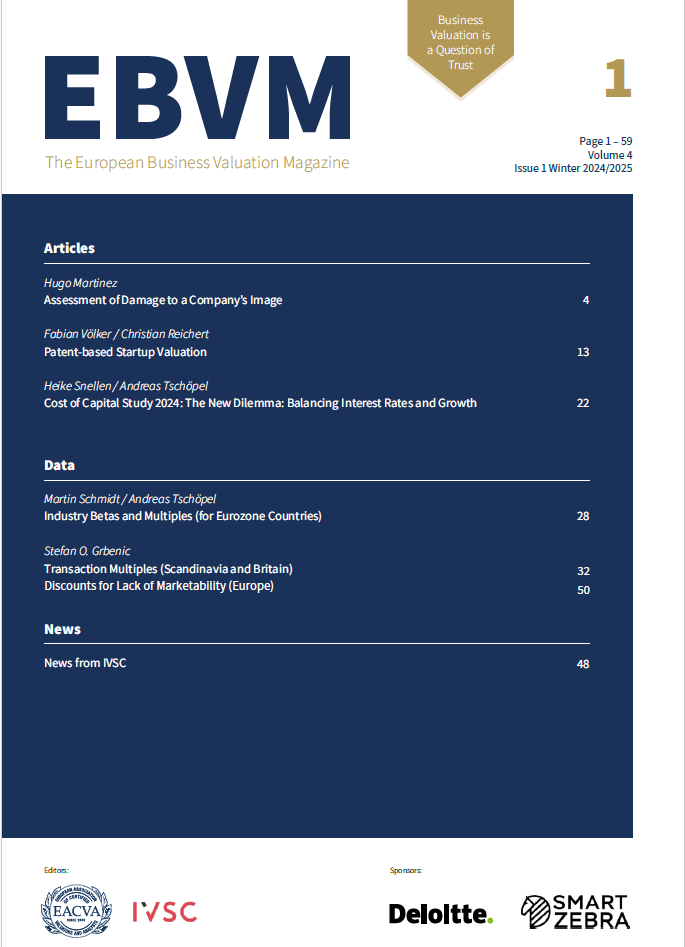European Business Valuation Magazine
Issue Winter 2024/2025

The European Association of Certified Valuators and Analysts (EACVA) and the International Valuation Standards Council (IVSC) are pleased to present the 10th issue of the new European Business Valuation Magazine (EBVM), published in February 2025.
- Editorial: Revision of the Business Valuation Standards in Germany and Austria: Exposure Drafts Published
Wolfgang Kniest, CVA - Assessment of Damage to a Companyʼs Image
Hugo Martinez - Patent-based Startup Valuation
Fabian Völker, M.Sc. / Dr. Christian Reichert, CVA, MBA - Cost of Capital Study 2024: The New Dilemma: Balancing Interest Rates and Growth
Heike Snellen / Dr. Andreas Tschöpel, CVA/CEFA/CIIA - Data: Industry Betas and Multiples (for Eurozone Companies)
Dr. Martin H. Schmidt / Dr. Andreas Tschöpel, CVA, CEFA, CIIA - Data: Transaction Multiples (Scandinavia and Britain)
Prof. Dr. Stefan O. Grbenic, StB, CVA - News from IVSC
- Data: Discounts for Lack of Marketability (Europe)
Prof. Dr. Stefan O. Grbenic, StB, CVA
Abstracts
At the end of 2024, the Institute of Public Auditors in Germany (IDW) and the Chamber of Chartered Accountants and Tax Consultants in Austria (KSW) have published draft versions of the respective business valuation standards (IDW S1 for Germany and KFS/BW 1 for Austria). The comment periods for both standards are currently open. Both standards explicitly distinguish between management planning as a starting point and planning for valuation purposes. This emphasises that future expected cash flows must be used as the basis for valuation and that these cash flows must be derived using plausible assumptions. Both standards emphasise three different areas of internal and external plausibility measures:
- Mathematical accuracy within and between the sub-plans as well as consistency of assumptions within individual sub-plans and between sub-plans;
- Material internal plausibility: comprehensibility and consistency of the planning with the explanations from management and quantitative and qualitative business analysis;
- Material external plausibility: Market analysis and analysis of competitors / benchmarking.
Plausibility is given when the underlying assumptions and the resulting plan figures are comprehensible, consistent and are in line with the findings of the market and competition analysis, the business analysis and the analysis of the company’s past financial performance.
A significant change in the draft version of the German business valuation standards is the dissolution of the mandatory link between the function of a valuator and the bases of value to be determined. Depending on the valuator’s responsibility with regard to the scope of the information used and the plausibility assessments of the assumptions underlying the planning for valuation purposes the draft version of the IDW S1 now separates three functions:
- Neutral valuer with comprehensive plausibility check preparing an expert opinion
- Neutral expert with sufficient plausibility check preparing an expert statement
- Advisor with no or insufficient plausibility check and reporting in the form of a calculated value.
In addition to the objectified business value (which was further developed in terms of content),
the new plausibilised decision value was introduced as a new valuation concept.
The most significant change in the draft of the revised KFS/BW 1 standard in Austria is the new inclusion of the market value as a value in exchange concept in addition to the already existing objectified business value as a value in use concept. The standardised subjective value in Austria is very similar in content to the plausibilised decision value in Germany.
We are eagerly awaiting the final standards and will keep you informed of these and other business valuation developments in the EBVM.
We hope you enjoy reading this issue.
Image is of strategic importance to a company. Damage to a company‘s image is therefore a financial loss that needs to be assessed, but no methodology has yet been developed to help financial experts carry out such an assessment. This article provides an
overview of the problem of damage to image and an example of how to go about assessing this loss. Readers will find keys to understanding the issue, as well as precise tools for carrying out such a valuation.
Missing historical financial data and prevalent operating losses are encumbering the valuation process of startup companies. In the motion control industry, however, patents are crucial to protect technological inventions and therefore contribute significantly to a company’s valuation. Based on these preconditions, a patent-based valuation approach for startups in the motion control industry is developed. The results of this article can directly be applied to startup valuations within the motion control industry. Otherwise, the methodology of this study can be used as a blueprint for comparable valuation models in other industry segments.
Recently, the 19th edition of the Cost of Capital Study by KPMG was published. As in previous years, the study highlights current developments in the preparation of financial forecasts and the derivation of cost of capital, as well as their impact on company values and business developments. This year‘s theme is „The New Dilemma: Balancing Interest Rates and Growth“.
All data has been obtained from the KPMG Valuation Data Source. The data source provides access to cost of capital parameters from more than 150 countries and sectors as well as peer-group-specific data from over 16,500 companies worldwide. The data covers the period from 2012 to the present. The data is updated monthly and is accessible from anywhere around the clock. See KPMG Valuation Data Source for details.
The computations of the transaction multiples are based on the transaction and company data collected from various M&A databases, with the data being driven to consistency.
We publish transaction multiples for Europe and resulting regression parameters (including transactions of the period 1 April 2021 until 31 March 2024) for the following multiples:
- Deal Enterprise Value/Sales
- Deal Enterprise Value/EBITDA
- Deal Enterprise Value/EBIT
- Deal Enterprise Value/Invested Capital